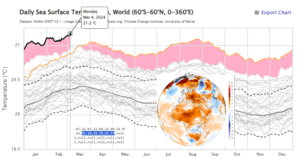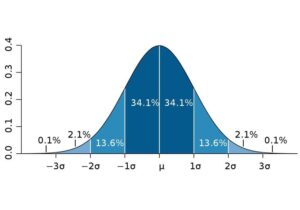Lost in endless political hype, this planet is hotter. Expert Earth System Modeler Till Kulhbrodt says this may be a glimpse of a future three degrees above pre-industrial. Are we approaching tipping points, or are some already behind us? We revisit an interview with Dr. Tim Lenton on cascading tipping points, as I line up guests to report the latest tipping science. The show closes with tips to survive times of mass fear.
But first, let’s learn more from the best, about how our planetary home really works. Welcome to Ecoshock. I’m Alex Smith.
Listen to or download this Radio Ecoshock show in CD Quality (57 MB) or LoFi (14 MB)
IS THIS WHAT 3 DEGREES HOTTER LOOKS LIKE?
TILL KULHBRODT
Graphs of sea surface temperatures are pretty scary lately, the hottest since measurements began. Is the recent flare-up El Nino or climate change to blame? Will hot seas last and what does that mean? New science suggests we are getting a glimpse of the future – a preview of a 3 degree hotter world.

We have reached Dr. Till Kuhlbrodt, Senior Research Fellow with the UK National Centre for Atmospheric Science. Based in the University Of Reading Department of Meteorology, Dr. Kuhlbrodt helps lead the United Kingdom Earth System Model. He is Lead Author of new work on two major warning signs from the sea.
Listen to or download this 27 minute interview with Till Kulhbrodt in CD Quality or LoFi
THE PAPER we discuss in the interview: “A glimpse into the future: The 2023 ocean temperature and sea-ice extremes in the context of longer-term climate change.” It was published January 17, 2004 in the Journal of the American Meteorological Society. This team’s new paper reports on two changes: a hotter Atlantic and disappearing sea ice around Antarctica.

The Abstract says “the North Atlantic does not show signs of a suggested significant step increase from less negative aerosol forcing since 2020”. So changes in ocean heating may be happening in the more heavily traveled shipping lanes of the Pacific with aerosol reduction, but not apparently from ship emission changes in the Atlantic. And yet there was extreme warming in the North Atlantic.
The paper says:
“As of August 2023, the North Atlantic was about 1.4C warmer than the 1982-2011 average (Figure 1a), and this value lies substantially outside the 2 [sigma] envelope. Indeed, both in July and September 2023 North Atlantic Sea Surface Temperature [SST] was outside the 4 [sigma] envelope for a couple of weeks.
In other words, in these two months of 2023 the observations were four standard deviations larger than the 1982-2011 average. Before 2023, even the warmest year since 1981 was only about 0.8 C, or 2 , above that average, illustrating the extreme scale of this warming event.”
SIMILAR RECORDS IN SOUTHERN OCEAN – THIS TIME FOR SEA ICE EXTENT
“The sea-ice extent in the Southern Ocean (Figure 1b) is similarly extreme as the North Atlantic SST. For August 2023, Antarctic sea-ice extent was about 2.4 million km2 smaller than the 1981-2011 average, and this value, as the ones for July and October, lies outside the 4 [sigma] envelope. From May all the way into November, Southern Ocean sea-ice extent was close to the 4 [sigma] curve.”
You can find a clear explanation of what “sigma” means in this MIT News brief, and why the 4 sigma excursion in the last decade has been so unusual and alarming.

The University of Reading Press Release makes it all clear:
““Record-high ocean temperatures observed in 2023 could become the norm if the world moved into a climate that is 3.0°C warmer than pre-industrial levels, according to a new study.
From March 2023, the North Atlantic began to show extremely warm temperatures far exceeding anything seen in the past 40 years. As of August 2023, the North Atlantic was about 1.4°C warmer than the 982-2011 average.
Analysis of climate model projections showed that last year’s extreme ocean conditions were similar to what scientists expect to be the average if global warming reaches 3°C of warming. Currently, global temperatures have risen by about 1.2°C above pre-industrial levels.”
Dr Till Kuhlbrodt told the University of Reading: “The extraordinary heat in the North Atlantic and missing sea ice in the Southern Ocean in 2023 tell us the oceans are sounding an alarm. We urgently need to understand exactly why parts of the ocean are warming rapidly so we can prepare for more frequent weather disruption across the planet. How often we get hit by more of these extremes hangs on figuring out what’s driving the Atlantic and Southern Oceans into uncharted territory.”
We cover all that and the Antarctic sea ice melt-back in the Radio Ecoshock interview. It plays like a news report from the real planet.
ANTARCTICA: A REGIME SHIFT?
In related papers, the American Meteorological Society published this (as they describe it):
“The Antarctic ocean-sea ice system may be fundamentally changing.
A paper by Will Hobbs and colleagues from the Australian Antarctic Program Partnership at the University of Tasmania notes evidence that Antarctic sea ice extent may be exhibiting a “regime shift.” While ice in the Southern Ocean plays a critical role in Antarctic climate—for example, reflecting heat from the sun—the extent of sea ice in summer months has become increasingly variable since 2006, and more closely correlated with the previous month’s sea ice rather than the atmospheric factors that normally drive it. The authors’ statistical analysis suggests that interactions between sea ice and the ocean below may have fundamentally changed (possibly related to global warming), driving this increased variability.”
Look for the paper “Observational Evidence for a Regime Shift in Summer Antarctic Sea Ice” here. You get the Abstract, but the full paper should be available later.
==================
GETTING UP TO SPEED ON TIPPING POINTS:
TIM LENTON (replay)

As I work out guests for a new tipping point report, we should refresh with this foundational interview with Dr. Tim Lenton from the University of Exeter. Lenton is a leader in this field, working with top scientists from other institutions like the Potsdam Institute and the Stockholm Resilience Centre. This will bring us up to speed on tipping points. Next week Lenton himself will talk to us about the latest 2023 update on tipping points.
Disaster in the Making: Cascading Tipping Points & Permafrost
In November 2020, just days before the Madrid COP25 Climate conference, a group of distinguished scientists published a Comment in the top journal Nature. It is titled: “Climate tipping points — too risky to bet against“. The paper is loaded with some renowned scientists, the majority of them coming from the Potsdam Institute in Germany. In addition to Tim Lenton they include Johan Rockström, Owen Gaffney, Stefan Rahmstorf, Katherine Richardson, Will Steffen and Hans Joachim Schellnhuber.
The authors say:
“We argue that the intervention time left to prevent tipping could already have shrunk towards zero, whereas the reaction time to achieve net zero emissions is 30 years at best. Hence we might already have lost control of whether tipping happens. A saving grace is that the rate at which damage accumulates from tipping — and hence the risk posed — could still be under our control to some extent.”
Listen to or download this 2020 Radio Ecoshock interview with Tim Lenton in CD Quality or Lo-Fi
That refresher interview from Radio Ecoshock was broadcast January 8 2020. Four years on, a new report on Global Tipping Points is out and we will go there in next week’s show for the update. This may be the most frightening aspect of climate change. Nobody is ready for it.
Maybe you will need this:
========================================
ARE YOU AFRAID?
– Alex Smith
Lot’s of people are trying to evaluate the appropriate level of panic, whether to check supplies in the bunker, run away, or just pull up the covers and hide. I have thoughts starting with a life story.
I did not know there was a “revolution” on both land and sea around 100 million years ago. The marine revolution reminds me of Medieval castle building. The stone defenses became thicker and more intricate – until more powerful cannon arrived. The castles became expensive hold-overs, no match for new war methods.
For hundreds of millions of years many ocean creatures built protective calcium shells, like castle walls. Then, in a period when continents were moving and climate changed sea levels, two new types of species appeared. One had jaws that could crunch shells. The others were worm-like creatures which could eat or dissolve small holes in shells and then enter through those breaches to devour the interior. Whole orders of creatures, including the brachiopods I collected as fossils as a child, were wiped out.
On land, between 100 and 50 million years ago, again believed due to climate change, flowering plants appeared in a terrestrial revolution. It was a wild time of creation of new shapes and colors. Flowering plants decorated this planet. Their arrival also drove development of new predators. It also prodded evolution in co-existing creatures like ants. A crazy number of ant species comes from that same time.
I’m sure there is something deep in all that.
My whole life and all human life have been on the knife edge of utter disaster since the development of nuclear weapons deliverable by missiles or bombers. One big flash, everything goes quiet, and dark nuclear winter sets in for eight to ten years. Whatever survives begins again.
Humanity suffered mass fears, real and imagined, as long as we have written records. One foundational source of multiple threats is the Hebrew Bible, and three religions believing it, the “People of the Book”. God sends floods, fires, pestilence. God approves His people committing genocide on others (in the Land of Canaan).
Through thousands of years the most settled people and seemingly powerful empires experienced a sudden arrival of hostile armies bent on looting and killing. Some attackers destroyed the cities of their victims and burned whatever would burn. The Mongols were a prime example. In more recent European history, the story living down through language was the appearance of “the Huns” around 400 of our Common Era..
During the late 1100’s and the 1200’s C. E., a relative warming developed in Europe, part of long term natural cycles and perhaps human agriculture. With better weather and thus improved crop yields, population increased. Then, in the middle of the 1300’s, the Black Plague arrived. Conservative estimates find over half of the population of Europe died. COVID, deadly and crippling as it is, is not as bad as the Plague which struck before any conceptions of science and modern medicine.
Therefore it is realistic and well-founded to sense the fragility of life. But that helpful evolutionary trait can attack societies, and the mind, like an auto-immune disease. History is filled with episodes of mass fear based on rational fears that did not happen. Some fast-spreading panics were based on mass delusion difficult for the modern mind to comprehend.
European Christians were instructed to prepare for the End Times, when Jesus returns to fight epic battles with the Devil. They promised most of humanity will be wiped out. These teachings were deeply embedded since earliest childhood and reinforced weekly if not daily. Periodically, masses of poor people walked away from their homes in search of a miracle or crusade, or just to wait for the Messiah. They died or were enslaved. Call it “superstition” but it survives well in modern minds and societies.

As Western colonialism dominated the world, this mental machinery was implanted in many parts of the world, or re-stimulated similar historic traumas in other societies.
This long-standing culturally inbred mass fear is used daily by Western news media, movies, and more. All that big fear goes on high-speed overdrive through telephones and social media. The most frightening videos, blogs, and podcasts are rewarded, by actual views and by advertising-driven algorithms.
Be aware: built-in mass fear is being stimulated and used against you. Be suspicious of the next rumor that collapse is coming tomorrow. Whether you choose to let that panic survival network in your brain kick-in – when, and how much – is still a choice for most people. Some may not be able to control the fear.
PERSONAL VERSUS SOCIAL DEATH
Complicating the fear: there is a tendency to confuse your own sense of unavoidable death with wide-spread death for others. We find this especially in older men, and less in women. Some older men specialize in preaching doom – the kind of Hell that will appear either soon or on a predicted date. They may claim a vision and signs, whether religious or not. The “end times” they preach is more likely their own end, their own under-acknowledged sense of person mortality.
NO ONE KNOWS THE FUTURE
While mass mortality events are possible, and getting more probable, no one knows the future for sure, at least in detail. This universe and life in it take surprising twists. Anyone with a “true” vision of the future is deluded and may want you to share the delusion. Be open to the idea that the future is an open system. That may not “save” you or people around you. The open future may be another “terrestrial revolution” where long-known species disappear and unsuspected life forms triumph.
Perhaps comforting and helpful for orientation: time is relative for us. For seniors, the wrenching collapse and new world order is unlikely to come in their remaining years. If it does come, and I must starve, I will. My life has been rich, more than all humans before me could have expected. My sadness and fear for my kids and grandchildren needs to be limited or re-directed into action, however small.
Why waste time and mental energy on despair? Why run away from remaining life? We can keep growing in understanding, in gifting, in art. New secrets of deep time and space are offered to us daily. Learn anything. As you explore the birth of flowering plants 100 million years ago, or birth in all living things, something in your the core feels joy. It is permissible to feel joy, even in the darkest days, as Holocaust survivor Viktor Frankel explained in his book “Man’s Search for Meaning”. There were marriages celebrated in the Death Camps. Personal growth and happiness can help repel mass fear and despair – if you let it.
Enjoy yourself – even if it is later than you think. That is how I try to live, despite knowing what I know. Let happiness, or at least contentment, bloom in your heart and mind for part of every day. Celebrate small things and occasions. Pass on a little love or at least understanding and empathy. Help someone or something. Find living Nature, daily if possible. Notice and nurture pleasure and good moments. If lost in memories, choose good destinations for your mind travel, not trauma and mistakes. Life is ludicrous and wild. Laugh.
Next week I will bring you more expert voices explaining humanity and life as we know it are in deeper trouble. Efforts and chances to save ourselves are tiny but not non-existent. If you can’t handle it, maybe tune out for a while. Disconnect and go outside. Breathe deep.
Along the way in this radio journey, we also recover millions of years of lost memory of this planet.. We acquire new amazement at the working of our planetary home, and yes, the continuing genius of humans. Amid warnings of dark death technologies, new ways of life and life-saving methods are also flocking into time. These are exciting times to be alive. Cherish them.
I’m Alex Smith. Thank you for listening, and caring about our world.
Thanks Alex, your work is appreciated.
I like your “big picture” perspective. Fear can be a terrible thing, especially about things we have no control over as the Stoics like to remind us.
There is still so much to be appreciated about this world, and still so many opportunities to find fulfillment in life.
Predicting the future is indeed a fools game, that said, there is a reason that an outfielder knows where to run if they are to catch a pop-fly in a game of baseball.
It’s easy to see the trajectory that the ball is on and, physics being what it is, then it would take a freak accident to alter that trajectory.
The trajectory of industrial civilization was clearly laid out 50 years ago in studies such as the Limits to Growth report. So far we are right on schedule, although the authors themselves warned that once we pass the inflection point and start going downhill then all bets are off. Anything could happen at that point.
Thanks for the thoughtful philosophical commentary added to the main content of your environmental discussions with climate experts